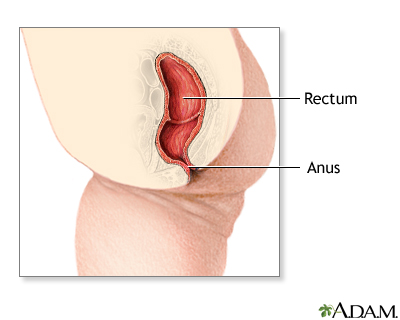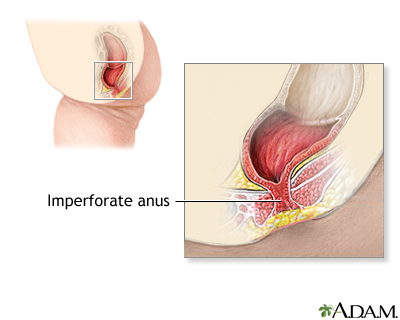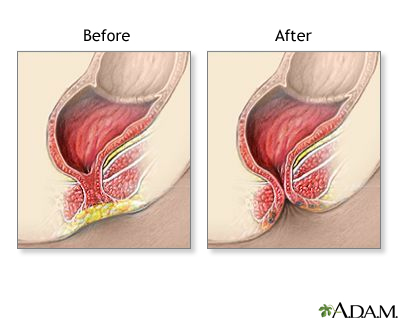Imperforate anus repair
| Normal anatomy |
|
In individuals with a normal anatomy, the large intestine (colon) empties into a pouch-like portion of bowel (rectum). Through complex nerve and muscle structures, the rectum releases stool through the anus out of the body.
|
|
| Indications |
|
This surgery is recommended to repair cases of imperforate anus and other anorectal malformations. There are two types of imperforate anus; a low type and a high type. The low type imperforate anus repair is illustrated.
|
|
| Procedure |
|
Surgical repair involves creating an opening for passage of stool. Complete absence of an anal opening requires emergency surgery for the newborn.
Surgical repairs are done while the baby is deep asleep and pain-free (using general anesthesia).
Surgery for a high type imperforate anus defect usually involves creation of a temporary opening of the large intestine (colon) onto the abdomen to allow passage of stool (this is called a colostomy). The baby is allowed to grow for several months before attempting the more complex anal repair.
The anal repair involves an abdominal incision, loosening the colon from its attachments in the abdomen to allow it to be repositioned. Through an anal incision, the rectal pouch is pulled down into place, and the anal opening is completed. The colostomy may be closed during this stage or may be left in place for a few more months and closed at a later stage.
Surgery for the low type imperforate anus (which frequently includes a fistula) involves closure of the fistula, creation of an anal opening, and repositioning the rectal pouch into the anal opening.
A major challenge for either type of defect and repair is finding, using, or creating adequate nerve and muscle structures around the rectum and anus to provide the child with the capacity for bowel control.
|
|
| Aftercare |
|
The child may require several days in the hospital. Dilatation of the new anus (to improve muscle tone and prevent narrowing) will begin in the hospital and continue for some months. Stool softeners and a high-residue diet will need to continue throughout childhood.
|
|

Review Date:
4/6/2025
Reviewed By:
Neil K. Kaneshiro, MD, MHA, Clinical Professor of Pediatrics, University of Washington School of Medicine, Seattle, WA. Also reviewed by David C. Dugdale, MD, Medical Director, Brenda Conaway, Editorial Director, and the A.D.A.M. Editorial team.
The information provided herein should not be used during any medical emergency or for the diagnosis or treatment of any medical condition. A licensed medical professional should be consulted for diagnosis and treatment of any and all medical conditions. Links to other sites are provided for information only -- they do not constitute endorsements of those other sites. No warranty of any kind, either expressed or implied, is made as to the accuracy, reliability, timeliness, or correctness of any translations made by a third-party service of the information provided herein into any other language. © 1997-
A.D.A.M., a business unit of Ebix, Inc. Any duplication or distribution of the information contained herein is strictly prohibited.
© 1997-

All rights reserved.
A.D.A.M. content is best viewed in IE9 or above, Firefox and Google Chrome browser.





